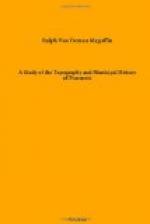The latest discussion of the subject was a joint debate held under the auspices of the Associazione Archeologica di Palestrina between Professors Marucchi and Vaglieri, which is published thus far only in the daily papers, the Corriere D’Italia of Oct. 2, 1907, and taken up in an article by Attilio Rossi in La Tribuna of October 11, 1907. Vaglieri, in the newspaper article quoted, holds that the mosaic is the work of Claudius Aelianus, who lived in the latter half of the second century A.D. Marucchi, in the same place, says that in the porticoes of the upper temple are traces of mosaic which he attributes to the gift of Sulla mentioned by Pliny XXXVI, 189, but in urging this he must shift delubrum Fortunae to the Cortina terrace and that is entirely impossible.
I may say that a careful study and a long paper on the Barberini mosaic has just been written by Cav. Francesco Coltellacci, Segretario Comunale di Palestrina, which I had the privilege of reading in manuscript.]
[Footnote 124: For the many opinions as to the subject of the mosaic, see Marucchi, Guida Arch., p. 75.]
[Footnote 125: This has been supposed to be a villa of Hadrian’s because the Braschi Antinoues was found here, and because we find bricks in the walls with stamps which date from Hadrian’s time. But the best proof that this building, which is under the modern cemetery, is Hadrian’s, is that the measurements of the walls are the same as those in his villa below Tibur. Dr. Van Deman, of the American School in Rome, spent two days with me in going over this building and comparing measurements with the villa at Tibur. I shall publish a plan of the villa in the near future. See Fernique, Etude sur Preneste, p. 120, for a meagre description of the villa.]
[Footnote 126: Delbrueck, l.c., p. 58, n. 1.]
[Footnote 127: The aerarium is under the temple and at the same time cut back into the solid rock of the cliff just across the road at one corner of the basilica. An aerarium at Rome under the temple of Saturn is always mentioned in this connection. There is also a chamber of the same sort at the upper end of the shops in front of the basilica Aemilia in the Roman Forum, to which Boni has given the name “carcere,” but Huelsen thinks rightly that it is a treasury of some sort. There is a like treasury in Pompeii back of the market, so Mau thinks, Vaglieri in Corriere D’Italia, Oct 2, 1907.]
[Footnote 128: See note 106.]
[Footnote 129: C.I.L., XIV, 2875. This dedication of “coques atriensis” probably belongs to the upper temple.]
[Footnote 130: Alle Quadrelle casale verso Cave e Valmontone, Cecconi, Storia di Palestrina, p. 70; Chaupy, Maison d’Horace, II, p. 317; Petrini, Memorie Prenestine, p. 326, n. 9.]
[Footnote 131: The martyr suffered death contra civitatem praenestinam ubi sunt duae viae, Marucchi, Guida Arch., p. 144, n. 3, from Martirol. Adonis, 18 Aug. Cod. Vat. Regin., n. 511 (11th cent. A.D.).]




